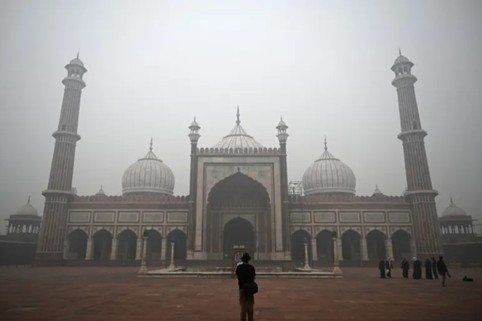
Current Situation
- Hazardous Air Quality:
- Delhi's Air Quality Index (AQI) recently reached a staggering 493, 30 times higher than WHO's safety limit.
- PM2.5, the primary pollutant, penetrates deep into lungs, posing severe health risks, especially to children, the elderly, and those with pre-existing conditions.
- Emergency Measures:
- Schools are shut, offices operate at half capacity, and non-essential construction is banned.
- Water tankers and mechanized sweeping aim to settle dust, while vehicular restrictions attempt to curb emissions.
Root Causes of Delhi's Smog Crisis
- Industrial and Vehicular Emissions:
- Coal remains India's primary energy source, powering over half of the country.
- Construction and millions of vehicles contribute significantly to air pollution.
- Stubble Burning:
- Farmers in neighboring states burn agricultural residue post-harvest, releasing vast amounts of smoke into the atmosphere.
- Winter Weather:
- Colder temperatures and heavier air trap pollutants close to the ground, exacerbating smog formation.
- Cultural Practices:
- Firecrackers during the Diwali festival, despite being regulated, add to pollution levels.
Proposed Solutions and Challenges
- Cloud Seeding for Artificial Rain:
- What It Is: A method using chemicals like silver iodide to stimulate rainfall by seeding clouds via aircraft or ground generators.
- Potential Benefits: Artificial rain could temporarily wash away pollutants.
- Concerns:
- Lack of consistent weather conditions for seeding to succeed.
- Environmental concerns over chemical use.
- Fails to address the underlying causes of pollution.
- Existing Policies:
- Bharat Stage Emission Standards (BSES): Modeled on European frameworks, these standards regulate emissions from vehicles but face implementation challenges.
- National Clean Air Programme (NCAP): Launched in 2019, targeting a 40% pollution reduction by 2026. Critics argue it lacks state-level integration and overlooks cross-border pollution sources.
- Local Measures in Delhi:
- Short-term actions like halting construction and reducing traffic offer limited respite.
- Mechanized sweeping and water sprinkling are stop-gap measures rather than long-term solutions.
Obstacles to Progress
- Political Blame Game:
- Delhi's Aam Aadmi Party (AAP) and the federal BJP government often trade accusations, hindering coordinated action.
- Economic Pressures:
- India's dependence on coal for energy and economic growth makes transitioning to cleaner alternatives challenging.
- Cultural and Social Barriers:
- Enforcement of bans on firecrackers and crop burning remains inconsistent.
- Farmers lack affordable alternatives to stubble burning.
- Inadequate Funding and Execution:
- Insufficient investment in renewable energy and pollution control technologies.
- Poor enforcement of existing environmental regulations.
Way Forward
- Comprehensive Regional Action:
- Integrated efforts across states to manage crop residue, industrial emissions, and vehicle pollution.
- Investment in Renewable Energy:
- Accelerating the transition from coal to renewable sources like solar and wind.
- Stronger Public Awareness Campaigns:
- Educating communities on the health impacts of air pollution and promoting eco-friendly practices.
- Innovative Solutions:
- Exploring scalable alternatives to stubble burning, such as bio-decomposers and agricultural waste recycling.
- Enhanced public transport and electric vehicle incentives to reduce dependence on personal vehicles.
Conclusion
Delhi's air pollution crisis reflects a complex interplay of environmental, economic, and political factors. While emergency measures like cloud seeding may offer temporary relief, addressing the root causes requires sustained, coordinated efforts at local, regional, and national levels. Without bold action, the toxic smog will continue to suffocate India's capital, jeopardizing public health and quality of life.